wheel size Oldsmobile Achieva 1997 Owner's Manuals
[x] Cancel search | Manufacturer: OLDSMOBILE, Model Year: 1997, Model line: Achieva, Model: Oldsmobile Achieva 1997Pages: 372, PDF Size: 18.52 MB
Page 228 of 372
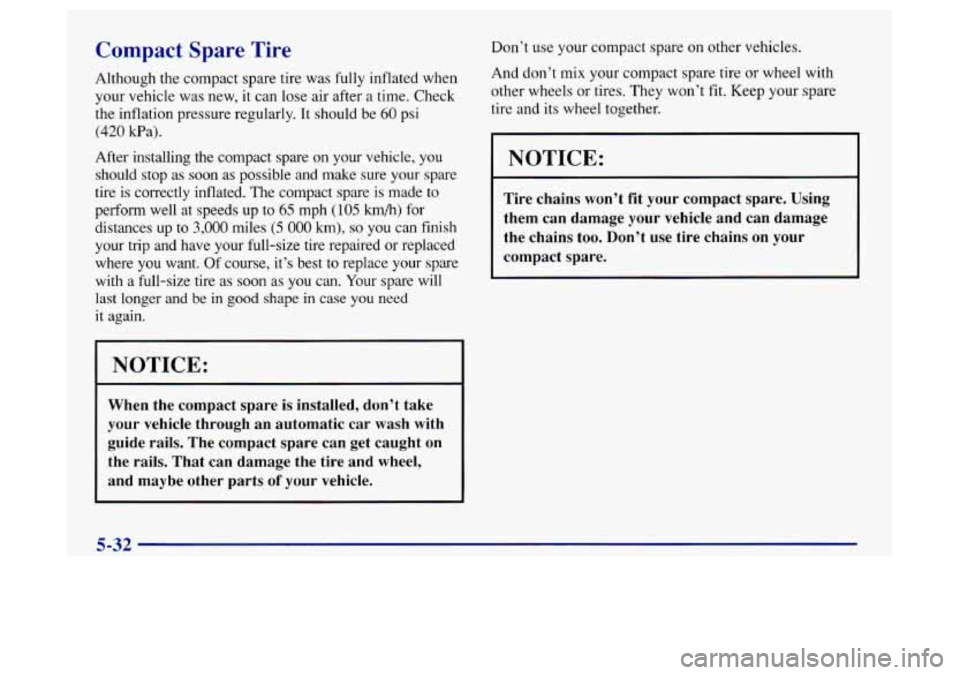
Compact Spare Tire
Although the compact spare tire was fully inflated when
your vehicle was new,
it can lose air after a time. Check
the inflation pressure regularly. It should be
60 psi
(420 Wa).
After installing the compact spare on your vehicle, you
should stop as soon as possible and make sure your spare
tire is correctly inflated. The compact spare
is made to
perform well at speeds up
to 65 mph (105 km/h) for
distances up to
3,000 miles (5 000 km), so you can finish
your trip and have your full-size tire repaired or replaced
where you want.
Of course, it’s best to replace your spare
with a full-size tire as
soon as you can. Your spare will
last longer and be in good shape in case
you need
it again.
NOTICE:
I
When the compact spare is installed, don’t take
your vehicle through an automatic car wash with
guide rails. The compact spare can get caught on
the rails. That can damage the tire and wheel,
and maybe other parts
of your vehicle. Don’t use your compact
spare
on other vehicles.
And don’t mix your compact spare tire or wheel with
other wheels or tires. They won’t fit. Keep your spare
tire and its wheel together.
NOTICE:
Tire chains won’t fit your compact spare. Using
them can damage
your vehicle and can damage
the chains too. Don’t use tire chains on
your
compact spare.
5-32
Page 273 of 372
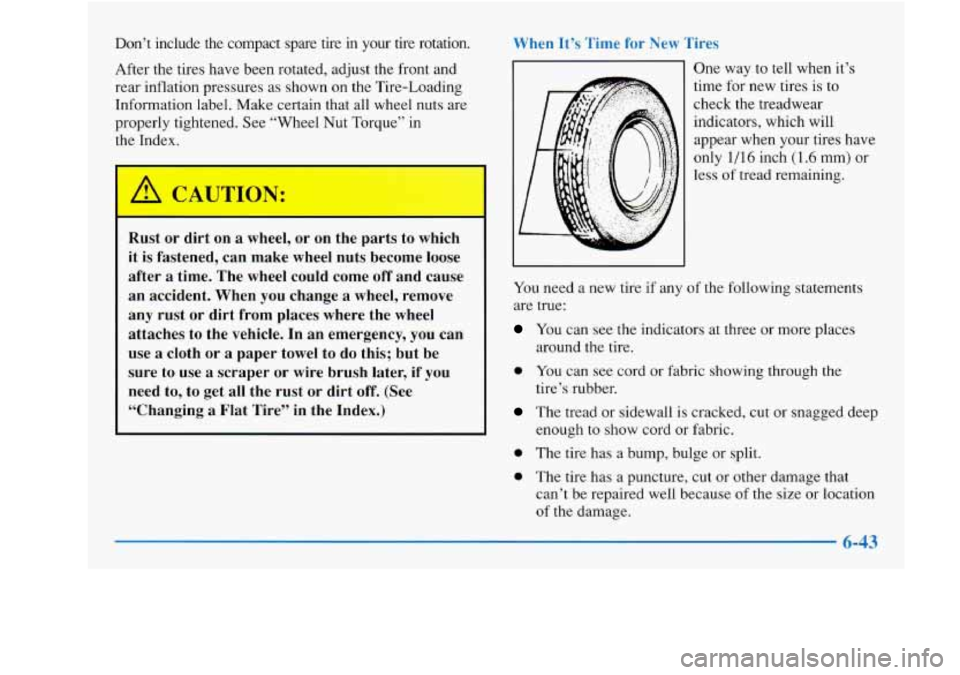
Don’t include the compact spare tire in your tire rotation. [t’s Time for New
After the tires have been rotated, adjust the front and
rear inflation pressures as shown
on the Tire-Loading
Information label. Make certain that all wheel nuts are
properly tightened. See “Wheel Nut Torque” in
the Index.
I
Rust or dirt on a wheel, or on the parts to which
it is fastened, can make wheel nuts become loose
after
a time. The wheel could come off and cause
an accident. When
you change a wheel, remove
any rust or dirt from places where the wheel
attaches to the vehicle. In an emergency, you can
use
a cloth or a paper towel to do this; but be
sure to use
a scraper or wire brush later, if you
need to, to get all the rust or dirt off. (See
“Changing
a Flat Tire” in the Index.)
kc
One way to tell when it’s
time for new tires is
to
check the treadwear
indicators, which will
appear when your tires have
only
1/16 inch (1.6 mm) or
less of tread remaining.
You need a new tire if any of the following statements
are true:
You can see the indicators at three or more places
around the tire.
0 You can see cord or fabric showing through the
The tread or sidewall is cracked, cut or snagged deep
tire’s rubber.
enough to show cord
or fabric.
0 The tire has a bump, bulge or split.
0 The tire has a puncture, cut or other damage that
can’t be repaired well because
of the size or location
of the damage.
6-43
Page 274 of 372
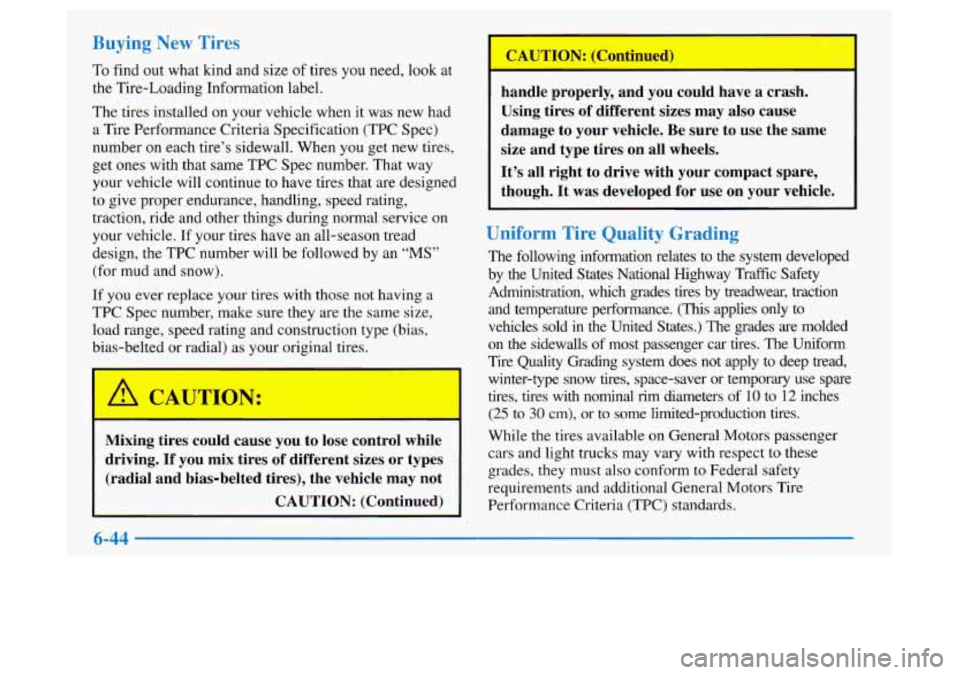
To find out what kind and size of tires you need, look at
the Tire-Loading Information label.
The tires installed on your vehicle when
it was new had
a Tire Performance Criteria Specification (TPC Spec)
number on each tire’s sidewall. When
you get new tires,
get ones with that same TPC Spec number. That way
your vehicle will continue to have tires that are designed
to give proper endurance, handling, speed rating,
traction, ride and other things during normal service on
your vehicle. If your tires have an all-season tread
design, the TPC number will be followed by an
“MS”
(for mud and snow).
If you ever replace your tires with those not having a
TPC Spec number, make sure they are the same size,
load range, speed rating and construction type (bias,
bias-belted or radial) as your original tires.
Mixing tires could cause you to lose control while
driving. If you mix tires of different sizes or types
(radial and bias-belted tires), the vehicle may not
CAUTION: (Continued)
I CAUTION: (Continuc
handle properly, and you could have a cradh.
Using tires of different sizes may also cause
damage to your vehicle. Be sure to use the same
size and type tires on all wheels.
It’s all right to drive with your compact spare,
thowh-
Tt was developed for use on your vehicle.
- -
Jniform I 11 lit A
The following information relates to the system developed
by the United States National Highway Traffic Safety
Administration, which grades tires by treadwear, traction
and temperature performance.
(This applies only to
vehicles sold in the United States.) The grades are molded
on the sidewalls
of most passenger car tires. The Uniform
Tire Quality Grading system does not apply to deep tread,
winter-type snow tires, space-saver or temporary use spare
tires, tires with nominal rim diameters
of 10 to 12 inches
(25 to 30 cm), or to some limited-production tires.
1
While the tires available on General Motors passenger
cars and light trucks may vary with respect to these
grades, they must also conform to Federal safety
requirements and additional General Motors Tire
Performance Criteria (TPC) standards.
Page 277 of 372

Used Replacement Wheels
Putting
a used wheel on your vehicle is
dangerous. You can’t know how it’s been used or
how far it’s been driven.
It could fail suddenly
and cause an accident. If you have to replace
a
wheel, use a new GM original equipment wheel.
Tire Chains
~. ~~ ~
NOTICE:
If your Oldsmobile has P195/65R15 size tires,
don’t use tire chains. They can damage your vehicle because there’s not enough clearance.
Use another type of traction device only if its
manufacturer recommends it for use on your
vehicle and tire size combination and road
conditions. Follow that manufacturer’s
instructions.
To help avoid damage to your
vehicle, drive slowly, readjust or remove the
device if it’s contacting your vehicle, and don’t
spin your wheels.
If you do find traction devices that will
fit, install
them on the front tires.
6-47
Page 285 of 372
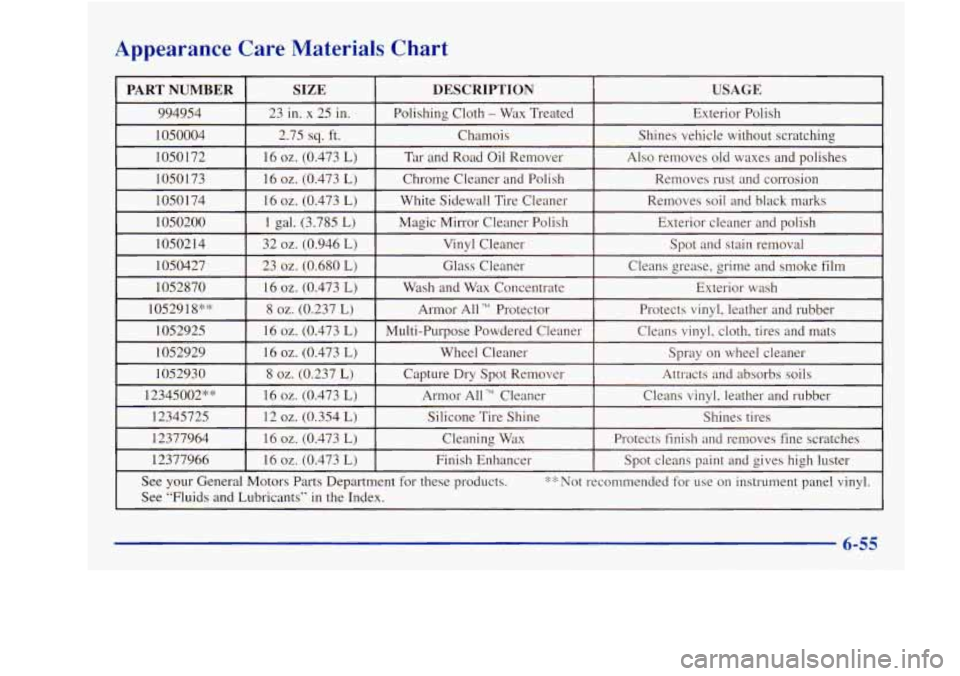
Appearance Care Materials Chart
PART NUMBER USAGE DESCRIPTION SIZE
994954 Exterior Polish
Polishing Cloth - Wax Treated
23 in. x
25 in.
1050004
Spot and stain removal
Vinyl Cleaner
32
oz. (0.946 L) 1050214 Exterior
cleaner and polish
Magic Mirror Cleaner Polish
1 gal. (3.785 L) 1050200 Removes
soil
and black marks White Sidewall Tire Cleaner
16 oz. (0.473
L)
1050174 Removes
rust and corrosion
Chrome Cleaner and Polish 16
oz. (0.473 L)
1050173 Also removes old waxes and polishes
Tar and Road Oil Remover
16
oz. (0.473 L) 1050 172 Shines vehicle without
scratching Chamois
2.75
sq. ft.
I I I
1050427 I 23 oz. (0.680 L) 1 Glass Cleaner Cleans grease, grime and smoke film
1052870 16 oz. (0.473 L) Wash and Wax Concentrate Exterior wash
1052918**
8 oz. (0.237 L) Armor All n4 Protector
Protects vinyl, leather and rubber
1052925 16
oz. (0.473 L) Multi-Purpose Powdered Cleaner Cleans vinyl, cloth, tires and mats
1052929 16
oz. (0.473 L) Wheel Cleaner
Spray on wheel cleaner
1052930
8 oz. (0.237 L) Capture Dry Spot Remover Attracts and absorbs
soils
12345002** 16
oz. (0.473 L) Armor All TM Cleaner
Cleans vinyl, leather and rubber
12345725 12
oz. (0.354 L) Silicone
Tire Shine Shines tires
12377964 16
oz. (0.473 L) Cleaning Wax Protects finish and removes fine scratches I I - I
12377966 I 16 oz. (0.473 L) I Finish Enhancer I Spot cleans paint and gives high luster
See your General Motors Parts Department for these products.
** Not recommended for use on instrument panel vinyl.
I See “Fluids and Lubricants” in the Index.
6-55
Page 292 of 372
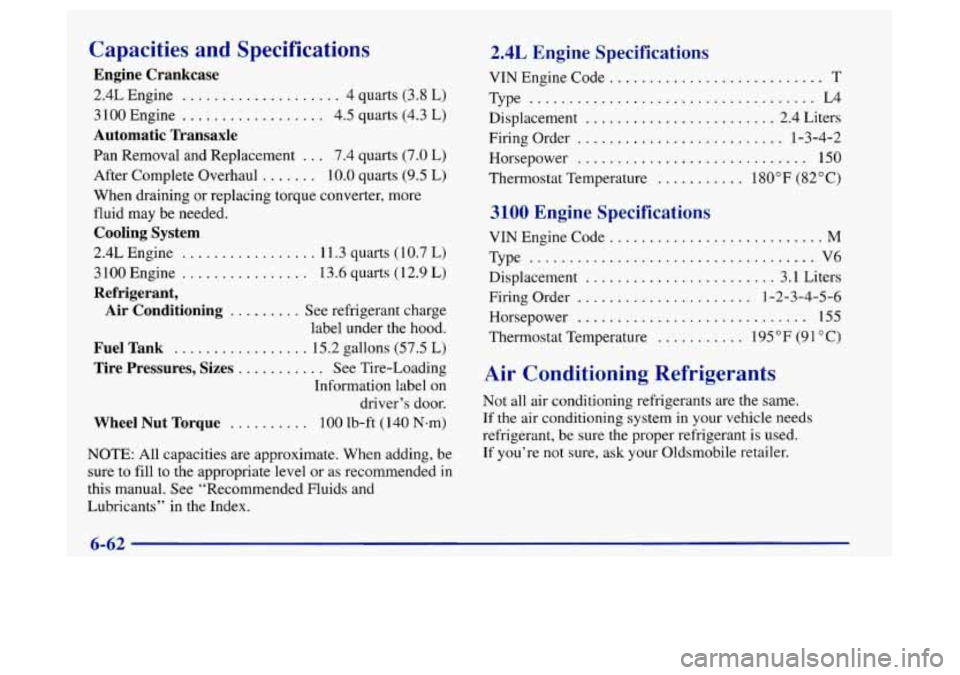
Capacities and Specifications
Engine Crankcase
2.4L Engine .................... 4 quarts (3.8 L)
3 100 Engine
.................. 4.5 quarts (4.3 L)
Automatic Transaxle
Pan Removal and Replacement ... 7.4 quarts (7.0 L)
After Complete Overhaul ....... 10.0 quarts (9.5 L)
When draining or replacing torque converter, more
fluid may be needed.
Cooling System
2.4LEngine ................. 11.3 quarts (10.7 L)
3100Engine
................ 13.6 quarts (12.9 L)
Refrigerant,
Air Conditioning
......... See refrigerant charge
label under the hood.
Fuel Tank ................. 15.2 gallons (57.5 L)
Tire Pressures, Sizes
........... See Tire-Loading
Information label on
driver’s door.
Wheel Nut Torque .......... 100 lb-ft (140 N-m)
NOTE: All capacities are approximate. When adding, be
sure to fill to the appropriate level or as recommended in
this manual. See “Recommended Fluids and
Lubricants” in the Index.
2.4L Engine Specifications
VINEngineCode ........................... T
Type .................................... L4
Displacement
........................ 2.4 Liters
Firing Order
.......................... 1-3-4-2
Thermostat Temperature
........... 180 OF (82 O C)
Horsepower ............................. 150
3100 Engine Specifications
VIN Engine Code ........................... M
Type .................................... V6
Displacement ........................ 3.1 Liters
Firing Order
...................... 1-2-3-4-5-6
Horsepower ............................. 155
Thermostat Temperature
........... 195°F (9 1 “C)
Air Conditioning Refrigerants
Not all air conditioning refrigerants are the same.
If the air conditioning system in your vehicle needs
refrigerant, be sure the proper refrigerant is used.
If you’re not sure, ask your Oldsmobile retailer.
6-62